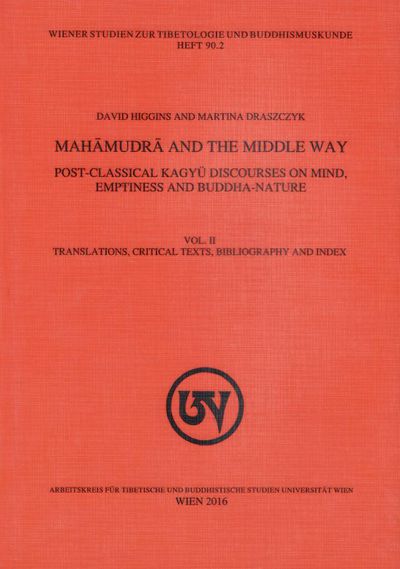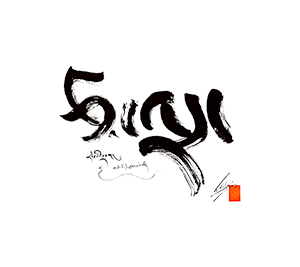- Acknowledgement 12
- Introduction 14
- Current State of Research 17
- Politico-Historical Background 22
- Doctrinal Background 25
- Navigating the Middle Ways 29
- The Nature of Liberating Knowledge 41
- Shākya mchog ldan 44
- Shākya mchog ldan and the Bka’ brgyud Mahāmudrā Tradition 45
- Life, Writings and Influences 51
- Madhyamaka and the Dialectic of Emptiness: Rang stong and Gzhan stong 57
- The Three Natures (trisvabhāva) 65
- The Two Truths (satyadvaya) 67
- Mahāmudrā and Buddha Nature 74
- Direct Perception and Nondual Wisdom 101
- The Great Seal in Shākya mchog ldan’s Mahāmudrā trilogy 109
- Mahāmudrā: What it is and What it is Not 109
- Madhyamaka, Mantrayāna and Mahāmudrā 116
- Mahāmudrā and What Remains (lhag ma : avasista) 121
- The Problem of Cessation 124
- Contested Methods of Realization 127
- Responses to Sa skya Pandita’s Criticism of Bka’ brgyud Mahāmudrā 131
- Concluding Remarks 145
- Karma phrin las 148
- Overview 149
- Life, Writings and Influences 156
- Madhyamaka Approach 159
- Extant Writings 168
- Views of Reality 169
- The Compatibility of Rang stong and Gzhan stong 169
- The Two Types of Purity 181
- Buddha Nature Endowed with Qualities 184
- On the Unity of the Two Truths 200
- “Thoughts are Dharmakāya” 210
- Understanding Coemergence: the Inseparability of Samsāra and Nirvana 217
- Concluding Remarks 223
- Karma pa Mi bskyod rdo rje 226
- Overview 227
- The Differentiation and Identification Models 229
- Reconciling Affirmation and Negation 238
- Life, Writings and Influences 242
- Blending Mahāmudrā and Madhyamaka 250
- Emptiness and Hermeneutics of the Three Turnings 253
- Core Soteriological Ideas and the Role of Philosophical Distinctions 265
- Buddha Nature 269
- Nature of Reality 275
- Nature of Mind 277
- The Problem of the Remainder (lhag ma : avasista) 299
- On the Prospect of a Groundless Ground 314
- On Whether or Not a Buddha has Wisdom 320
- Mahāmudrā as Mental Nonengagement (amanasikāra) 325
- Concluding Remarks 341
- Padma dkar po 342
- Overview 343
- Life, Writings and Influences 347
- The Basic Framework: Mahāmudrā and the Unity of the Two Truths 350
- Emptiness and the Hermeneutics of the Three Turnings 352
- Hermeneutics of Mahāmudrā as Ground and Path 356
- The Two Faces of Mahāmudrā: the Modes of Abiding and Error 357
- Mahāmudrā as the Mode of Abiding (gnas lugs phyag chen) 359
- Mahāmudrā in the Mode of Error ( ’khrul lugs phyag chen) 363
- Yang dgon pa on the Two Modes of Mahāmudrā 369
- Padma dkar po’s Transposition of Yang dgon pa’s Distinction 376
- Interpretations of the Mahāmudrā Distinction 378
- Mahāmudrā and the Unity of the Two Truths 382
- Asymmetrical Unity and Rival Truth Theories (Jo nang and Dge lugs) 385
- The Ground of Truth 393
- Path Mahāmudrā and Liberating Knowledge 398
- Nonconceptual Knowing in the Shadow of the Bsam yas Debate 399
- Three Strands of Amanasikāra Interpretation in Indian Buddhism 403
- Padma dkar po’s Three Grammatical Interpretations of Amanasikāra 413
- Responding to Criticisms of Amanasikāra 422
- Concluding Remarks 426
- Final Reflections 429
This two-volume publication explores the complex philosophy of Mahāmudrā that developed in Tibetan Dwags po Bka’ brgyud traditions between the 15th and 16th centuries CE. It examines the attempts to articulate and defend Bka’ brgyud views and practices by four leading post-classical thinkers: (1) Shākya mchog ldan (1423‒1507), a celebrated yet controversial Sa skya scholar who developed a strong affiliation with the Karma Bka’ brgyud Mahāmudrā tradition in the last half of his life, (2) Karma phrin las Phyogs las rnam rgyal (1456‒1539), a renowned Karma Bka’ brgyud scholar-yogin and tutor to the Eighth Karma pa, (3) the Eighth Karma pa himself, Mi bskyod rdo rje (1507‒1554), who was among the most erudite and influential scholar-hierarchs of his generation, (4) and Padma dkar po (1527‒1592), Fourth ’Brug chen of the ’Brug pa Bka’ brgyud lineage who is generally acknowledged as its greatest scholar and systematizer. It is an important academic work published in the Vienna series WSTB and is divided into two volumes: the first offers a detailed philosophical analysis of the authors’ principal views and justifications of Mahāmudrā against the background of Indian and Tibetan Buddhist doctrines on mind, emptiness and buddha nature; the second comprises an annotated anthology of their seminal writings on Mahāmudrā accompanied by critical editions and introductions. These two volumes are the result of research that was generously funded by the Austrian Science Fund (FWF) from 2012 to 2015 under the supervision of Prof. Klaus-Dieter Mathes. The project was entitled “‘Emptiness of Other’ (Gzhan stong) in the Tibetan ‘Great Seal’ (Mahāmudrā) Traditions of the 15th and 16th Centuries” (FWF Project number P23826-G15). (Source: WSTB Description)
| Citation | Higgins, David, and Martina Draszczyk. Mahāmudrā and the Middle Way: Post-Classical Kagyü Discourses on Mind, Emptiness and Buddha-Nature. Vol. II, Translations, Critical Texts, Bibliography and Index. Wiener Studien zur Tibetologie und Buddhismuskunde 90.2. Vienna: Arbeitskreis für Tibetische und Buddhistische Studien Universität Wien, 2016. |
|---|---|
David Higgins and Martina Draszczyk's Mahāmudrā And The Middle Way is a study of four Tibetan philosophers from the fifteenth and sixteenth centuries who attempted to forge a middle way between contemporary doctrinal extremes regarding Mahāmudrā and buddha-nature theory. Three of the four authors were Kagyu: Karma Trinle Chokle Namgyel, the Eighth Karmapa, and the Fourth Drukchen Pema Karpo, and one was Sakya, Śākya Chokden, who was, late in life, a student of the Seventh Karmapa. The four authors did not agree with each other, all finding their own ways to steer, as Higgins and Draszczyk put it, "a middle course between the Scylla and Charybdis of eternalism and nihilism." All four authors studied were "scholar-yogis," -- philosophers who were also keenly interested and accomplished in the meditative practices of their traditions. Higgins and Draszczyk position the four as responding to the doctrinal extremes of the Geluk and Jonang traditions, the first representing nihilism of Tsongkhapa's interpretation of Candrakīrti, and the second being Dolpopa's teaching on gzhan stong. All four wrote in an era in which Geluk Prasangika was becoming dominant, in a language that suggested an anti-Tantric polemic; Geluk and Sakya authors were rejecting Saraha, an Indian saint whose writings form part of the Mahāmudrā canon. Certainly the two hierarchs of Kagyu traditions could not afford to leave their central doctrines undefended. This perspective is true to the authors studied, but it should be noted that followers of the Geluk or Jonang would certainly not accept the label of extremism, and would -- and did -- view the authors' positions as intellectually naive. Still, the four attempts at reconciliation between doctrinal poles are a needed corrective to the many studies in which the extremes are presented as contradictory; for all four authors the philosophical binaries were complementary and integral to the practice of Buddhism. They each advocated for an intellectual inquiry of emptiness using the language of negation favored by Geluk and mainline Sakya teachers, paired with or followed by a meditative engagement with positive-language doctrines of buddha-nature and the natural luminosity of mind. The great debates of the era between Madhyamaka and Yogacāra, gzhan stong and rang stong, analytical or meditative approach, Sudden vs. Gradual Enlightenment, and so forth, were for these authors not issues of either / or but matters of synthesis and balance.
- PaN chen shAkya mchog ldan. phyag rgya chen po gsal bar byed pa'i bstan bcos tshangs pa'i 'khor lo. In gsung 'bum shAkya mchog ldan, Vol. 17: 359-412. Kathmandu: sachen international, 2006.

- karma phrin las pa. dri lan yid kyi mun sel zhes bya ba lcags mo'i dris lan. In chos kyi rje karma phrin las pa'i gsung 'bum las rdo rje'i mgur gyi phreng ba dang thun mong ba'i dris lan gyi phreng ba. New Delhi: ngawang topgay, 1975: 88-92.

- ____________. yin lug sgrog pa lta ba'i mgur. In chos kyi rje karma phrin las pa'i gsung 'bum las rdo rje'i mgur gyi phreng ba dang thun mong ba'i dris lan gyi phreng ba. New Delhi: ngawang topgay, 1975: 8-10.

- ____________. rdo rje mgur. In chos kyi rje karma phrin las pa'i gsung 'bum las rdo rje'i mgur gyi phreng ba dang thun mong ba'i dris lan gyi phreng ba. New Delhi: ngawang topgay, 1975: 43-44.

- mi bskyod rdo rje. bdud rtsi'i dri mchog. In gsung 'bum mi bskyod rdo rje, Vol. 15: 975-1024. Lhasa: s.n., 2004.

- ____________. bla ma khams pa'i dris lan mi gcig sems gnyis. In gsung 'bum mi bskyod rdo rje, Vol. 3: 219-223. Lhasa: s.n., 2004.

- ____________. zab mo phyag chen gyi mdzod sna tshogs 'dus pa'i gter. In gsung 'bum mi bskyod rdo rje, Vol. 15: 1025-1038. Lhasa: s.n., 2004.

- ____________. sku gsum ngo sprod rnam bshad. In gsung 'bum mi bskyod rdo rje, Vol. 21: 208-210. Lhasa: s.n., 2004.

- ____________. dgongs gcig 'grel pa. In gsung 'bum mi bskyod rdo rje, Vol. 6: 98-102. Lhasa: s.n., 2004.

- pad+ma dkar po. phyag chen rgyal ba'i gan mdzod. In gsung 'bum pad+ma dkar po, Vol. 21: 38-42, 173-192. Darjeeling: kargyud sungrab nyamso khang, 1973-1974.

- ____________. klan ka gzhom pa'i gtam. In gsung 'bum pad+ma dkar po, Vol. 21: 553-561. Darjeeling: kargyud sungrab nyamso khang, 1973-1974.

- ____________. shar rtse zhal snga'i brgal lan. In gsung 'bum pad+ma dkar po, Vol. 21: 585-587. Darjeeling: kargyud sungrab nyamso khang, 1973-1974.

- ____________. snying po don gyi man ngag. In gsung 'bum pad+ma dkar po, Vol. 21: 414-415. Darjeeling: kargyud sungrab nyamso khang, 1973-1974.


